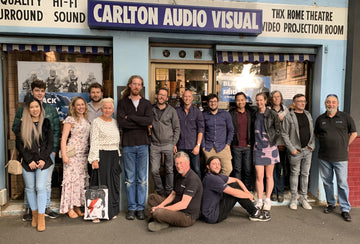A custom home audio video solution can take many forms, so it can be difficult to arrive at a specific definition. At the broadest level of physical description, a custom AV solution involves a collection of AV equipment that more or less is permantly installed as part of the home, rather than a stand alone system than can be moved from room to room, or house to house. At the functional level, a custom AV solution is one that is tailored to a person or group of people's needs. Typically, this involves the distribution of audio, and possibly video, throughout the home. More advanced solutions provide greater levels of remote control, and the control of other things such as lighting, blinds, heating, cooling, etc. The term "home integration" is often used to describe the latter.
Although interest in complete custom home AV solutions continues to grow, the average consumer is still very much in the dark as to the issues that surround designing a custom home system, wiring a home, and choosing appropriate hardware. Rather than covering all these areas, the following is offered to shed some light on what kinds of custom AV solutions are most sought after, and the various associated costs of each. It is intended to provide some context for those in the throws of considering the purchase of a custom AV solution.
Broadly speaking, there are currently three tiers of products available. The top tier includes fully customisable systems such as Crestron. This product allows for infinite flexibility, albeit at a price; A Creston distributed audio / control system involves around $25,000 in hardware (not including speakers, home theatre electronics or source components), and that amount again in programming.
At the other end of the spectrum are “off-the-shelf” systems like the NuVo Essentia ($3500) and HAL CC-1040 ($8500). Both include 6 stereo channels of amplification, and keypad and remote controls, effectively catering for six different areas of the home (zones). The HAL system allows more zones to be added, and the system can be upgraded to include video distribution and full integration and control of lighting, heating, cooling, blinds, etc. Multiple sources can be distributed around the home via these types of systems, with a music server type-device being the logical and most popular source device.
Three main issues should be considered prior to wiring for a basic distributed audio / control system. These are: (1) capacity for independent sources in multiple zones; (2) the level of control available in each zone, and (3) the cost of achieving independent sources and a high level of control in multiple zones.
Music playing off a basic music sever device, like an ordinary home PC, can be distributed to all zones. However, one cannot play different music in each zone at the same time. The same music has to be played in each area, albeit with independent volume control, rather than different music in each area. A more advanced music server device, one with multiple independent audio outputs, allows for independent MP3 streams to multiple zones, but a price of at least $7000.
Controlling music in each area of the home is usually limited to volume, source selection, and track skipping. What is typically lacking in basic distributed audio / control systems is bi-directional communication between control interface (e.g., on wall keypad or handheld remote) and music server device. Bi-directional communication allows a music collection stored to hard drive to be visually displayed on a screen of some description. Thus one is able to effectively navigate there music collection and pre-programmed play lists, in areas of the home other than where the music server device is located. Usually, bi-directional control is provided in rather expensive tablet type remote control devices (expect to pay around $3500-$4000), or via handheld remotes and TV screens (necessitate the purchase of a TV screen for every area where music server navigation is required.
In short, basic distributed audio and control systems lack multiple and independent MP3 music streams, and are limited to local control rather than full global control of source devices. The ability to provide independent MP3 music streams, and global control, can be added to some basic systems, but generally at a cost of several thousand dollars.
Recently, a category of product that fits in between advanced systems like Creston, and basic systems such as the NuVo, has become available. An example is Control 4 and HAL Helix. Both offer much of the flexibility of a Crestron system, but at a far lower price, in terms of both hardware and programming costs. These systems, like a Crestron system, can be programmed to control a home theatre system, lighting, blinds, music server, video distribution system, etc.; both are capable of full home automation according to user defined schedules. More zones can be added to each system in piecemeal fashion, providing cables are routed to the relevant areas of the home.
The Control 4 system is particularly effective and cost effective for several reasons. The Control 4 system will access music off a home computer network, and will then stream MP3 music to multiple independent zones at the one time, such that a separate and costly stand alone music server device is not needed. Furthermore, a bi-directional remote control at $300 allows easy navigation of a music collection from anywhere in the home. A Control 4 system can be programmed to run most audio visual and remote controllable devices in a home, all displayed on remote handset screen, on wall LCD touchpad, or on a TV screen. It is also suitable for retrofitting, as it can be configured as a wired and / or wireless system. As such, it represents an incredibly powerful and cost effective distributed audio and control system. The HAL Helix system also has its strength, in that its features closely resemble a fully specified Crestron system at a much reduced price point.
Video distribution is a little more complicated than audio distribution. Video distribution systems differ in the number of source inputs (e.g., Foxtel box, digital free-to-air, DVD, PC, etc.) and the number of video outputs (video zones or rooms), and in the quality of video signal being sent through the home. The lowest grade is RF (just like tuning each TV in to a local TV broadcast). Above this is composite video (colours all on one cable), and then component video (red, green, blue transmitted on individual cables). Composite video is far better than RF in terms of colour and lack of noise/grain, and component is considerable improvement again.
Where both audio and video is to be distributed, and video is sent as an analogue signal (which it usually is), then audio also must be sent as an analogue signal, otherwise audio and video can be out of sync. This means that three runs of component video cable, and two runs of analogue audio cable, must be routed to each video zone. This is costly, and requires a considerable amount of labour. Furthermore, for independent video sources in multiple zones, multiple set-top and / or pay-TV boxes are required. Clearly adding video distribution to a home is far more costly and complex than adding audio distribution.
In summary, there are several functional and cost related issues a consumer needs to consider before making decisions regarding wiring a home for distributed audio and video, control and device integration, and what equipment is to be installed. For system designers, programmers, and installers, it means managing an enormous number of variables, from what equipment to specify and where to locate it, to how a home is to be wired, to how the system is to be programmed. In practice, for a system to achieve a user’s end needs, the design process will ideally involve a team of experienced and talented individuals, made up of programmers, installers, and audio visual consultants. The chief designer needs to be clearly aware of the end user’s requirements, and the limitations and strengths of the products available on the market at any given time.
Opinions





